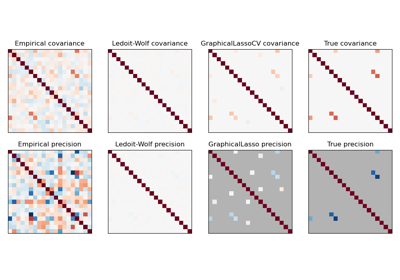sklearn.datasets.make_sparse_spd_matrix¶
- sklearn.datasets.make_sparse_spd_matrix(dim=1, *, alpha=0.95, norm_diag=False, smallest_coef=0.1, largest_coef=0.9, random_state=None)[source]¶
Generate a sparse symmetric definite positive matrix.
Read more in the User Guide.
- Parameters:
- dimint, default=1
The size of the random matrix to generate.
- alphafloat, default=0.95
The probability that a coefficient is zero (see notes). Larger values enforce more sparsity. The value should be in the range 0 and 1.
- norm_diagbool, default=False
Whether to normalize the output matrix to make the leading diagonal elements all 1.
- smallest_coeffloat, default=0.1
The value of the smallest coefficient between 0 and 1.
- largest_coeffloat, default=0.9
The value of the largest coefficient between 0 and 1.
- random_stateint, RandomState instance or None, default=None
Determines random number generation for dataset creation. Pass an int for reproducible output across multiple function calls. See Glossary.
- Returns:
- precsparse matrix of shape (dim, dim)
The generated matrix.
See also
make_spd_matrixGenerate a random symmetric, positive-definite matrix.
Notes
The sparsity is actually imposed on the cholesky factor of the matrix. Thus alpha does not translate directly into the filling fraction of the matrix itself.

